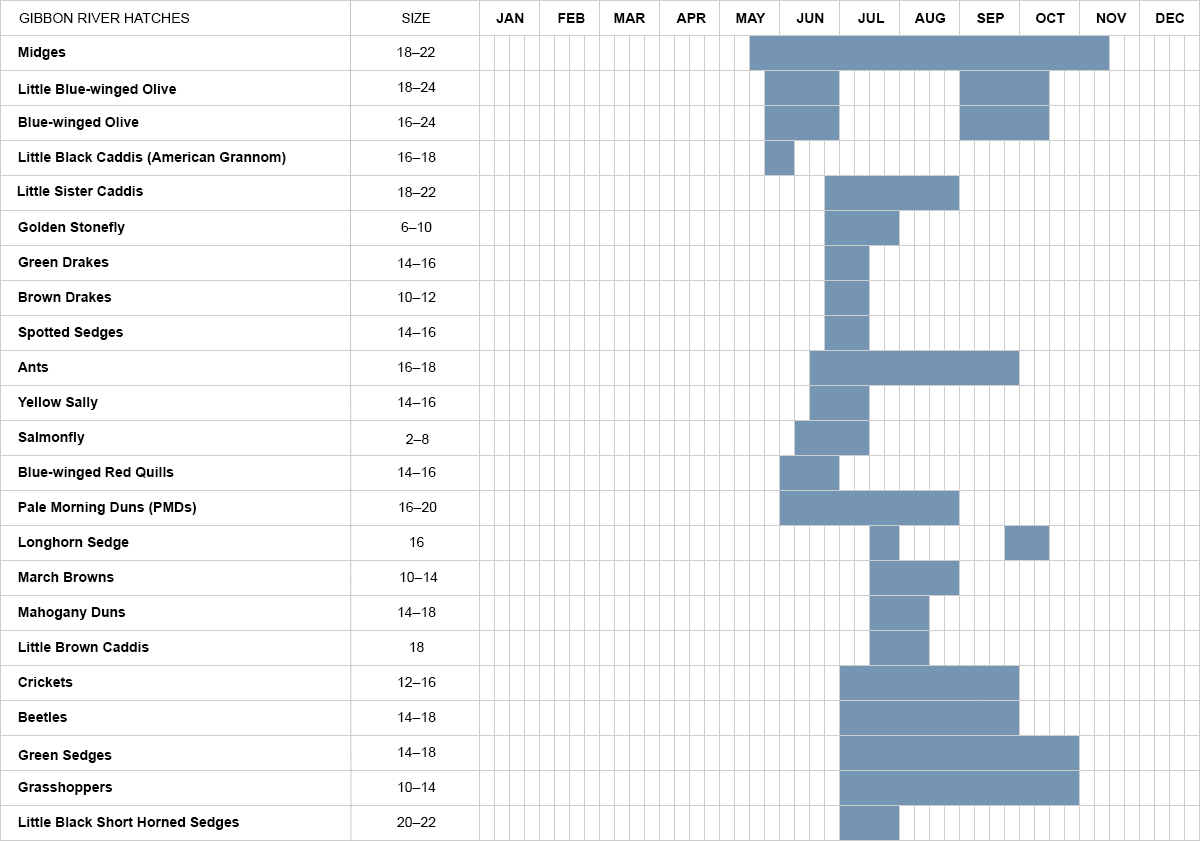The Gibbon River is divided by several major waterfalls along its course. Each section of the river supports a unique fishery and provides excellent fly fishing opportunities. As good as the fishing can be, trout on the Gibbon can be finicky feeders and matching the hatch is critical.

The following hatch chart for Gibbon River identifies the major fly hatches, recommended fly sizes by hatch, and peak hatch dates. Hatch dates may vary from year to year and are influenced by water conditions.
| Fly Hatch | Size | Date |
|---|---|---|
| Midges | 18–22 | May 15 - Nov 15 |
| Little Blue-winged Olive | 18–24 | May 25 - June 30; Sep 1 - Oct 15 |
| Blue-winged Olive | 16–24 | May 25 - June 30; Sep 1 - Oct 15 |
| Little Black Caddis (American Grannom) | 16–18 | May 25 - June 10 |
| Little Sister Caddis | 18–22 | June 25 - Aug 31 |
| Golden Stonefly | 6–10 | June 20 - July 30 |
| Green Drakes | 14–16 | June 20 - July 15 |
| Brown Drakes | 10–12 | June 20 - July 15 |
| Spotted Sedges | 14–16 | June 20 - Aug 15 |
| Ants | 16–18 | June 15 - Sep 30 |
| Yellow Sally | 14–16 | June 15 - July 15 |
| Salmonfly | 2–8 | June 10 - July 15 |
| Blue-winged Red Quills | 14-16 | June 1 - June 30 |
| Pale Morning Duns (PMDs) | 16–20 | June 1 - Aug 31 |
| Longhorn Sedge | 16 | July 15 - July 31; Sep 20 - Oct 15 |
| March Browns | 10–14 | July 15 - Aug 31 |
| Mahogany Duns | 14–18 | July 15 - Aug 15 |
| Little Brown Caddis | 18 | July 15 - Aug 15 |
| Crickets | 12–16 | July 1 - Sep 30 |
| Beetles | 14–18 | July 1 - Sep 30 |
| Green Sedges | 14–18 | July 1 - Oct 31 |
| Grasshoppers | 10–14 | July 1 - Oct 31 |
| Little Black Short Horned Sedges | 20–22 | July 1 - July 30 |
Major Fly Hatches on the Gibbon River
Fly hatches along the Gibbon River are abundant throughout the spring and summer, with a few hatches extending into late fall. Major hatches consist of mayflies, caddis, and stoneflies.
On the section of the Gibbon River between Norris and Gibbon Meadows, Brown Trout in the 8″ to 20″ range are the predominate fish. Matching the hatch here is critical. Brown and Green Drake, as well as PMD, are the major hacthes along this stretch.
From Gibbon Meadows to Gibbon Falls stonefly and caddis are the predominant hatches. Attractor dry flies that mimic small stoneflies or larger caddis are most productive.
Along the lower 5 mile stretch from Gibbon Falls to Mouth, nymphing is going to be most productive. A stonefly nymph with a small caddis dropper is going to catch you as many fish as anything else. For dry flies, general attractors or terrestrials are your go-to patterns.
During fall nymphing or streamer fishing is the most productive technique to generate consistent bites. Anglers report that fishing a stonefly trailed by a baetis nymph is an effective presentation.
Where you find cold, swift, boulder strewn, pocket water environments along the Gibbon River you may also find Salmonflies. Salmonfly hatches are most prolific during the months of June and July. Anglers should always keep a salmonfly pattern or two handy just in case they happen upon a hatch.
For dry fly enthusiasts one of the best stonefly patterns for fishing the Gibbon River during early summer is a #14-16 Olive Stimulator. If you’re nymphing try a #16 Oliver Montana Princes (Prince Nymph).



